
#349 – November 5, 2017
It has been more than five years ago since Shiloh Winery was profiled on this newsletter and things have certainly changed since 2012 when it was still a relative newcomer to the scene. As can be seen in my interview of the principal owner in 2014, much has changed over the years including a near tenfold increase in production and a portfolio expansion to over 15 wines. However, despite all these changes the winery’s fundamental style has remained consistent and the primary personal behind Shiloh have remained the same, enabling sure and steady improvements over the year, both qualitative and commercial.
Eponymously named for the Shomron village it calls home, the winery is located in Shiloh’s industrial area, adjacent to Tel Shiloh. Before losing the title to Jerusalem during the acrimonious divide of the ancient kingdoms of Judah and Israel during the time of the prophets, Tel Shiloh was Israel’s ancient capital and is generally accepted to be the permanent location of the Mishkan. Located in an area dotted with ancient grape presses and other archeological evidence of local ancient winemaking, the winery takes the ancient connections to the land and its winemaking very seriously as it writes a new winemaking chapter in the region’s book of winemaking history.
Ancient Ties
 Any conversation with Shiloh’s winemaker will be dotted with to this historic connection and quotes from the bible and other sources evidencing the ties between the region and the Jewish people, typically seen through the prism of winemaking and the marketing materials all reference this ancient connection. Whether utilizing Jacob’s timeless blessing to Joseph from which the winery’s logo is derived (whose portion of biblical Israel included the land on which the winery sits) including Rashi’s interpretation regarding the superior sweetness inherent in the region’s fruits or the words of the prophet Yechezkel, the deep-rooted and heartfelt connection to the land is obvious to all. The bull in the winery’s logo is derived from that ancient blessing and is supposed to represent the winery’s strength and passion along with its unbreakable connection to the past and commitment to the future.
Any conversation with Shiloh’s winemaker will be dotted with to this historic connection and quotes from the bible and other sources evidencing the ties between the region and the Jewish people, typically seen through the prism of winemaking and the marketing materials all reference this ancient connection. Whether utilizing Jacob’s timeless blessing to Joseph from which the winery’s logo is derived (whose portion of biblical Israel included the land on which the winery sits) including Rashi’s interpretation regarding the superior sweetness inherent in the region’s fruits or the words of the prophet Yechezkel, the deep-rooted and heartfelt connection to the land is obvious to all. The bull in the winery’s logo is derived from that ancient blessing and is supposed to represent the winery’s strength and passion along with its unbreakable connection to the past and commitment to the future.
The recently launched sub-label Hero’s Edition (tasting notes below) is just another example of the deep religious beliefs that guide the winery. Intended to honor the religious vintners allow their land to lay fallow during the Shmitah year, the series alludes to G-d’s promise for an exceptionally bountiful pre-Shmitah year harvest for those who follow the commandments of Shmittah.
Principals with Principles
The winery’s principal owner is Mayer Chomer, a Mexican lawyer, law professor and successful businessman. While living in Spain and working on his doctorate, Mayer became frustrated with the lack of accessibility to quality kosher wine and resolved to do something about it. With a deep-rooted love for Israel and a passion for wine, he decided to combine the two and a modern winery.
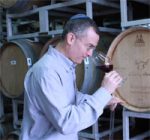 The curious and innovative Amichai Luria is Shiloh’s winemaker and CEO. Born in the US, his family made aliyah when he was four. Fast forward a few years and Amichai is married, living in the Shomron, working as a general building contractor (“kablan”) and, most importantly for us, cultivating a newfound passion in wine. Blessed with immense natural curiosity and a dedication to perfection, Amichai set out to learn as much about wine and the winemaking process as possible, an ongoing educational process whose only official aspect was a practical course in winemaking at Sorek Winery that he took with his wife.
The curious and innovative Amichai Luria is Shiloh’s winemaker and CEO. Born in the US, his family made aliyah when he was four. Fast forward a few years and Amichai is married, living in the Shomron, working as a general building contractor (“kablan”) and, most importantly for us, cultivating a newfound passion in wine. Blessed with immense natural curiosity and a dedication to perfection, Amichai set out to learn as much about wine and the winemaking process as possible, an ongoing educational process whose only official aspect was a practical course in winemaking at Sorek Winery that he took with his wife.
A Journey’s Beginning
While any self-respecting winemaker is always learning new things and looking to improve, this autodidactic winemaker took things to the extreme after deciding to start making wine as a hobby. While his enlisting of local experts and utilization of a nearby winery’s facilities are common among budding or hobbyist winemakers, I am pretty he has no peers in the excavation of a wine cave outside his home in Ma’ale Levona to serve as a facility for his budding winemaking operations.
 His first foray into winemaking as for the 2000 vintage, a homemade vintage of approximately 3,000 bottles that were well received. Encouraged by his initial success, Amichai continued to make wine for a few additional vintages before determining to officially acknowledge that his passion and hobby had reached a level were the establishment of a commercial winery made sense. It was around this time that he meet his future business partner – Mayer.
His first foray into winemaking as for the 2000 vintage, a homemade vintage of approximately 3,000 bottles that were well received. Encouraged by his initial success, Amichai continued to make wine for a few additional vintages before determining to officially acknowledge that his passion and hobby had reached a level were the establishment of a commercial winery made sense. It was around this time that he meet his future business partner – Mayer.
A Fortuitous Meeting
The paths of these two men collided around the time that Mayer was contemplating bringing his Israeli winery plans to fruition and Amichai’s winemaking had grown to such a degree that a choice was coming. Whether fate, divine intervention or by happenstance, Mayer found himself one evening enjoying a social event at Amichai’s home, where his Bordeaux blend was being served and immensely enjoyed by everyone, including Mayer. Astonished to discover that the winemaker was none other than his lovely host, Mayer immediately suggested the two of them team up to turn their individual dreams of a commercial Israeli winery into the collective reality which ended up as Shiloh Winery.
A Different Method of Winemaking

Over the years Amichai has helped assuage any potential issues from his lack of formal winemaking education by seeking professional guidance from Israeli wine consultant Itai Lahat (who continues to advise, albeit on a lessor basis), while also benefiting from the advice of Dr. Arkadi Papikian, Ilane Abitbol and others along the way. However, Amichai strongly believes that coming to winemaking as a hobbyist yielded exceptional benefits to his education and played a big part in the winery’s success. He feels that the lack of constraint to conventional rules and wisdom which can develop through traditional winemaking education, freed him to experiment and try anything his creative mind could conceive. While I am not convinced as to the theoretical aspects of his hypothesis, there is no denying his extensive and continuous experimentation with different barrels, vineyards, fermentation temperatures and techniques among others; a process which continuously encourages improvement and has undoubtedly contributed to the qualitative improvement the winery has shown over the years. .
With access to vineyards spread across the region’s exceptional terroir, including many vineyards planted at elevation levels exceeding 800 meters and blessed with prime grape growing conditions, the winery is primed to be a perfect spokesperson for the Shomron as a top-tier Israeli grape growing region. However, in another deviation from traditional winemaking, Amichai tries to make the best wine he can while taking advantage of the greatest resources available to him and sources from many locations throughout Israel. With individual wines containing grapes from as diverse terroirs as Shiloh and Dalton, Amichai’s wines are more indicative of his winemaking than any individual location, making them less representative of the region than some of his neighboring peers. However, at least one well-known regional aspect is incorporated into the portfolio; Merlot’s dominance over Cabernet Sauvignon as the more powerful grape, evidenced by its primary role in the winery’s flagship Mosaic wine.
A Different Method for Mevushal
 Launched in 2005 with an initial commercial vintage of approximately 20,000 bottles, the winery has grown over the years hitting approximately 80,000 bottles for the 2010 vintage and expected to reach nearly 200,000 bottles for the 2017 vintage. With Israeli annual wine consumption hovering under 11 liters per person, the growth market for any kosher winery is the kosher-observing wine consuming population, the largest segment of which lives in the US. With ever-growing production levels, Shiloh has a huge focus on the export market with close to 60% of its production destined for overseas markets, the majority of which finds its way to the United States. After a period of time where many wineries significantly reduced the number of mevushal wines in their portfolio (primarily driven by an inability to achieve sufficient quality), recent years have seen an increase in such offerings, mostly as a result of importer request to service the rapidly growing number of consumers who require mevushal wines for a variety of reasons. While these wines also end up in restaurants (where the US lags behind the rest of the world and only mevushal wines are allowed), the bulk of increased production is destined for caterers, large events and wine stores. With such a focus on export, it shouldn’t surprise you that over 50% of Shiloh’s wines are mevushal with an increasing number of wines being produced in both formats (a practice mostly abandoned by many other wineries). Other than the Secret Cabernet Sauvignon and the Mosaic series (effectively their most expensive/prestigious wine), all wines are exported only in one format – either mevushal or non-mevushal.
Launched in 2005 with an initial commercial vintage of approximately 20,000 bottles, the winery has grown over the years hitting approximately 80,000 bottles for the 2010 vintage and expected to reach nearly 200,000 bottles for the 2017 vintage. With Israeli annual wine consumption hovering under 11 liters per person, the growth market for any kosher winery is the kosher-observing wine consuming population, the largest segment of which lives in the US. With ever-growing production levels, Shiloh has a huge focus on the export market with close to 60% of its production destined for overseas markets, the majority of which finds its way to the United States. After a period of time where many wineries significantly reduced the number of mevushal wines in their portfolio (primarily driven by an inability to achieve sufficient quality), recent years have seen an increase in such offerings, mostly as a result of importer request to service the rapidly growing number of consumers who require mevushal wines for a variety of reasons. While these wines also end up in restaurants (where the US lags behind the rest of the world and only mevushal wines are allowed), the bulk of increased production is destined for caterers, large events and wine stores. With such a focus on export, it shouldn’t surprise you that over 50% of Shiloh’s wines are mevushal with an increasing number of wines being produced in both formats (a practice mostly abandoned by many other wineries). Other than the Secret Cabernet Sauvignon and the Mosaic series (effectively their most expensive/prestigious wine), all wines are exported only in one format – either mevushal or non-mevushal.
 A coming newsletter will deal with the various intricacies of making mevushal wines, including the many different options for doing so as the topic certainly warrants a newsletter of its own. However, I will point out that while many wineries run the wines through the mevushalizing process on the bottling line (i.e. once the entire winemaking process is complete), certain wineries (or individual, usually more expensive wines) are mevushalized earlier in the winemaking process, which allows more post-process winemaker intervention and can yield better results. Drawing heavily on his contractor background and utilizing a hefty dose of innovative creativity along with some serious moxie, Amichai claims to have developed a proprietary method for flash pasteurization (i.e. “mevushalizing”) that doesn’t impact the wine’s taste. Modern technology has made it easier to produce mevushal wines for immediate consumption without significantly impacting taste leaving long-term aging ability as the main issue to crack. While some wineries have a proven track record of cracking this phenomenon (e.g. Herzog and Hagafen), Shiloh’s success in this arena remains to be, although recent experimentation has sometimes yielded positive results (see tasting notes below).
A coming newsletter will deal with the various intricacies of making mevushal wines, including the many different options for doing so as the topic certainly warrants a newsletter of its own. However, I will point out that while many wineries run the wines through the mevushalizing process on the bottling line (i.e. once the entire winemaking process is complete), certain wineries (or individual, usually more expensive wines) are mevushalized earlier in the winemaking process, which allows more post-process winemaker intervention and can yield better results. Drawing heavily on his contractor background and utilizing a hefty dose of innovative creativity along with some serious moxie, Amichai claims to have developed a proprietary method for flash pasteurization (i.e. “mevushalizing”) that doesn’t impact the wine’s taste. Modern technology has made it easier to produce mevushal wines for immediate consumption without significantly impacting taste leaving long-term aging ability as the main issue to crack. While some wineries have a proven track record of cracking this phenomenon (e.g. Herzog and Hagafen), Shiloh’s success in this arena remains to be, although recent experimentation has sometimes yielded positive results (see tasting notes below).
Style by Choice
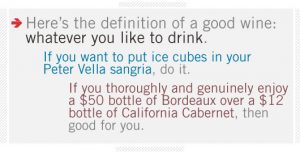 After an inaugural vintage in which the winery utilized only the primary Bordeaux varietals of Cabernet Sauvignon, Merlot and Shiraz, it started to incorporate other Bordeaux varietals like Cabernet Franc, Petit Verdot and Chardonnay while adding a few additional varietals like Barbera and Petite Sirah. As many of Shiloh’s peers have begun experimenting with what are colloquially referred to as “Mediterranean Varietals” while attempting to create wines they feel are more suited to Israel hot climate, Amichai has stuck to his stylistic guns and continues to produce the wines he knows his primary customers love – bold, oaked and ripe wines (although recent years have seen an attempt at earlier harvest in order to temper the potential for over-ripeness and ensure sufficient acidity). While focusing on bigger wines and a judicious use of oak, Amichai’s experimentation with oak usage is incredible and his winemaking abilities are evident in wines that retain good balance between the fruit, oak, tannins and other components of the wine while yielding delicious wines that are generally approachable on release (fulfilling the desire of most consumers). Many wines also have potential for continued aging and development in the bottle (serving the needs of more discerning aficionados as well), with a number of wines showing an surprising elegance for such big wines.
After an inaugural vintage in which the winery utilized only the primary Bordeaux varietals of Cabernet Sauvignon, Merlot and Shiraz, it started to incorporate other Bordeaux varietals like Cabernet Franc, Petit Verdot and Chardonnay while adding a few additional varietals like Barbera and Petite Sirah. As many of Shiloh’s peers have begun experimenting with what are colloquially referred to as “Mediterranean Varietals” while attempting to create wines they feel are more suited to Israel hot climate, Amichai has stuck to his stylistic guns and continues to produce the wines he knows his primary customers love – bold, oaked and ripe wines (although recent years have seen an attempt at earlier harvest in order to temper the potential for over-ripeness and ensure sufficient acidity). While focusing on bigger wines and a judicious use of oak, Amichai’s experimentation with oak usage is incredible and his winemaking abilities are evident in wines that retain good balance between the fruit, oak, tannins and other components of the wine while yielding delicious wines that are generally approachable on release (fulfilling the desire of most consumers). Many wines also have potential for continued aging and development in the bottle (serving the needs of more discerning aficionados as well), with a number of wines showing an surprising elegance for such big wines.
Winds of Change
Following the 2012 vintage, the winery made a number of changes with the goal of taking the quality to the next level. These changes including dropping many vineyards that Amichai felt were providing fruit of insufficient quality and replacing them with higher quality (and more expensive) vineyards. Another change was significantly reducing the use of American oak in favor or more French oak and the incorporation of larger, 400 liter oak barrels for a number of the wines (less wine to oak contact reduces the oak’s impact on the wines). The impact of these type of changes can take time to be fully evident but the winery’s offering have definitely seen an uptick in quality starting with the 2013 vintage.
The Wines
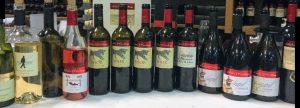 Shiloh currently produces wines across five different labels. Its entry-level series “Shiloh” includes a Rosé, Sauvignon Blanc, Chardonnay and a red blend dubbed Privilege. Amichai also has a new and not-yet-named white blend that is unlikely to be released, at least for the 2016 vintage. Next up comes is the Shor label, which includes the winery’s famous Barbera along with varietal versions of Cabernet Sauvignon and Cabernet Franc (not all are produced on an annual/consistent basis). Next up are the two Legend blends – Fiddler (the original Legend) and Choni (previously known as Legend II), named after the famous Talmudic sage Choni HaMa’agel.
Shiloh currently produces wines across five different labels. Its entry-level series “Shiloh” includes a Rosé, Sauvignon Blanc, Chardonnay and a red blend dubbed Privilege. Amichai also has a new and not-yet-named white blend that is unlikely to be released, at least for the 2016 vintage. Next up comes is the Shor label, which includes the winery’s famous Barbera along with varietal versions of Cabernet Sauvignon and Cabernet Franc (not all are produced on an annual/consistent basis). Next up are the two Legend blends – Fiddler (the original Legend) and Choni (previously known as Legend II), named after the famous Talmudic sage Choni HaMa’agel.
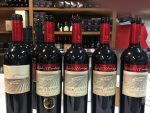 The winery’s reserve-level series is called Secret and it includes the varietal offerings of Cabernet Sauvignon, Merlot and Shiraz (the delightful Petite Sirah has yet to reappear as a varietal blend). As I mentioned above, for the 2014 vintage, Amichai produced a special sub-label within Secret dubbed – Hero’s Edition – three single vineyard Cabernet Sauvignon wines named after the owner of vineyard and paying homage to their steadfast religious beliefs in the face of potential economic adversity (these wines are only available in the US or through the winery). Finally the winery’s flagship label is the Mosaic blend which also includes an extra-special version called Mosaic Exclusive Edition in certain years. Historically Shiloh also produced a port-style wine called Fort which seems to have been discontinued for now and in 2007, Amichai produced a one-off dessert wine made from 100% late harvested Chardonnay grapes.
The winery’s reserve-level series is called Secret and it includes the varietal offerings of Cabernet Sauvignon, Merlot and Shiraz (the delightful Petite Sirah has yet to reappear as a varietal blend). As I mentioned above, for the 2014 vintage, Amichai produced a special sub-label within Secret dubbed – Hero’s Edition – three single vineyard Cabernet Sauvignon wines named after the owner of vineyard and paying homage to their steadfast religious beliefs in the face of potential economic adversity (these wines are only available in the US or through the winery). Finally the winery’s flagship label is the Mosaic blend which also includes an extra-special version called Mosaic Exclusive Edition in certain years. Historically Shiloh also produced a port-style wine called Fort which seems to have been discontinued for now and in 2007, Amichai produced a one-off dessert wine made from 100% late harvested Chardonnay grapes.
In addition to the winery’s labeled wines, 5-10% of the winery’s production is allocated for white label production or private labels for or individuals.
Tireless Marketing
 As I constantly remind winemakers, while the winemakers responsibility to the wine is finished once it’s been bottled, the real work is only beginning. Wineries are ultimately businesses who need to make money by selling wine and most wine doesn’t sell itself. A winemaker who believes in and loves his job and product is among the most powerful marketing tools and Amichai takes this aspect of his job extremely seriously with great results. Constantly promoting the wines at every turn, Amichai effectively uses social media (primarily Facebook) to introduce an ever-increasing audience to his wines, typically accompanied by the ridiculous meat-driven endeavors he undertakes at every turn, using meat as an incredible receptacle and accompaniment for his wines. Every winemaker should take note as his playbook is stock full of what a winery should be doing if it wants to achieve commercial success to go with lovely wines. Obviously Amichai’s job is made easier by the simple fact that he truly loves what he does and believes in it on multiple levels, but any winemaker who can’t say the same thing about himself is probably in the wrong profession.
As I constantly remind winemakers, while the winemakers responsibility to the wine is finished once it’s been bottled, the real work is only beginning. Wineries are ultimately businesses who need to make money by selling wine and most wine doesn’t sell itself. A winemaker who believes in and loves his job and product is among the most powerful marketing tools and Amichai takes this aspect of his job extremely seriously with great results. Constantly promoting the wines at every turn, Amichai effectively uses social media (primarily Facebook) to introduce an ever-increasing audience to his wines, typically accompanied by the ridiculous meat-driven endeavors he undertakes at every turn, using meat as an incredible receptacle and accompaniment for his wines. Every winemaker should take note as his playbook is stock full of what a winery should be doing if it wants to achieve commercial success to go with lovely wines. Obviously Amichai’s job is made easier by the simple fact that he truly loves what he does and believes in it on multiple levels, but any winemaker who can’t say the same thing about himself is probably in the wrong profession.
An Epic Tasting
Listed below are tasting notes for many of the wines I tasted on a recent visit to the winery. While my abbreviated time table required a rain check for one of Amichai’s famous meat-driving bonanzas, I was lucky enough to enjoy a wide-ranging tasting of over 30 wines. The tasting showcased both the breadth and depth of the winery’s offerings, with a horizontal tasting of the current releases along with multiple vertical tastings that offered a window into the winery’s progress throughout the years. In addition to the finished wines listed below, we also sampled some of the 2016 barrels including versions of Shiraz, Cabernet Sauvignon and Merlot in addition to preliminary versions of the 2016 Mosaic, all of which indicated that 2016 will continue the winery’s upward qualitative trajectory, ensuring we should be looking for continued improvement and great things from Amichai in in the years to come.
Shabbat Shalom,
Yossie
“Shiloh”
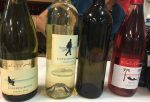 In addition to the wines listed below, from this series our tasting also included the 2016 Rose (a blend of Barbera (65%) and Cabernet Franc (35%)), the 2016 Sauvignon Blanc, sourced from Shiloh and Dalton and a 2016 experimental blend of Chardonnay and Sauvignon Blanc of which only two barrels were made and which will not be commercially released for this vintage.
In addition to the wines listed below, from this series our tasting also included the 2016 Rose (a blend of Barbera (65%) and Cabernet Franc (35%)), the 2016 Sauvignon Blanc, sourced from Shiloh and Dalton and a 2016 experimental blend of Chardonnay and Sauvignon Blanc of which only two barrels were made and which will not be commercially released for this vintage.
Shiloh, Chardonnay, 2015: 100% Chardonnay sourced from the 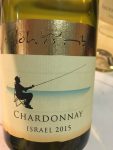 winery’s adjacent vineyards, which spent 6 months aging in new 400 liter French oak barrels. The nose is subdued but opens up with air and some gentle warming in the hands to reveal lovely bright fresh notes of tart green apple, Bartlett pear, quince and fresh baked brioche tinged with toasty oak. Good acidity provides a solid backbone for the wine’s structure and plenty of warm spices and more rich fruit complete the picture for a lovely and delicious medium bodied wine. A lingering finish with more spice provides a pleasing reminder to refill your glass – an easy endeavor at 13.2% AbV. Drink now through 2018 [Shmitah / Only in Israel].
winery’s adjacent vineyards, which spent 6 months aging in new 400 liter French oak barrels. The nose is subdued but opens up with air and some gentle warming in the hands to reveal lovely bright fresh notes of tart green apple, Bartlett pear, quince and fresh baked brioche tinged with toasty oak. Good acidity provides a solid backbone for the wine’s structure and plenty of warm spices and more rich fruit complete the picture for a lovely and delicious medium bodied wine. A lingering finish with more spice provides a pleasing reminder to refill your glass – an easy endeavor at 13.2% AbV. Drink now through 2018 [Shmitah / Only in Israel].
“Shor”
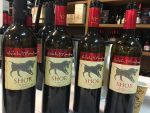 We focused on the Barbera for purposes of this tasting – a grape that has historically done well for Shiloh with great acidity and rich expressive fruit. Our vertical tasting included the following vintages: 2008 (Drink Now), 2011, 2014 (in noticeable mevushal format) and the 2015 (Shmitah).
We focused on the Barbera for purposes of this tasting – a grape that has historically done well for Shiloh with great acidity and rich expressive fruit. Our vertical tasting included the following vintages: 2008 (Drink Now), 2011, 2014 (in noticeable mevushal format) and the 2015 (Shmitah).
Shiloh, Shor, Barbera, 2011: Showing extremely well, the wine showcased rich, expressive and mostly red fruit and warm spices on the nose and medium to full bodied palate, backed up by bright acidity and accentuated with spicy oak and notes of cedar, fresh-rolled cigar, chocolate and roasted coffee beans. A lingering and slightly spicy finish lingers pleasantly. Drink now through 2018.
Shiloh, Shor, Barbera, 2015: Still a little shaky, the wine was recently bottled and still needs some time to come together, but shows much better after 45 minutes or so of air with rich cherries and plums along with some earthy minerals and slightly toasty oak back up by great acidity and robust tannins that are sill getting to know each other but bode well for the wine’s short-term future. Drink mid-2018 through 2020 [Shmitah / Only in Israel].
“Privilege”
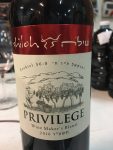 Shiloh, Privilege, Winemakers Blend, 2016: Shiloh’s new “mainstream” wine is a blend of Cabernet Sauvignon (65%), Syrah (18%), Cabernet Franc (12%) and Grenache (5%) which spent approximately 9 months aging with French oak, a small percentage of which was new. A sexy and expressive nose is loaded cherries, blackberries and tart raspberries is accentuated with a hint of blueberries along with black pepper, rich earth and a lovely overlay of floral notes on a well balanced backbone of good acidity and nicely integrated tannins and clocking in at 14.9% AbV. Drink now through 2018, maybe longer [mevushal].
Shiloh, Privilege, Winemakers Blend, 2016: Shiloh’s new “mainstream” wine is a blend of Cabernet Sauvignon (65%), Syrah (18%), Cabernet Franc (12%) and Grenache (5%) which spent approximately 9 months aging with French oak, a small percentage of which was new. A sexy and expressive nose is loaded cherries, blackberries and tart raspberries is accentuated with a hint of blueberries along with black pepper, rich earth and a lovely overlay of floral notes on a well balanced backbone of good acidity and nicely integrated tannins and clocking in at 14.9% AbV. Drink now through 2018, maybe longer [mevushal].
“Legend”
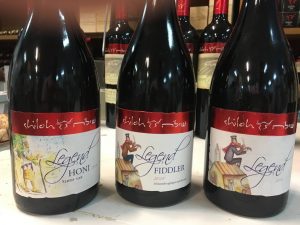 Following the trend popularized by Carmel with their eponymously named Mediterranean blend, Shiloh launched the Legend series with the 2009 vintage intending the wine as its own version of an Israeli blend. While currently more akin to Bordeaux and Rhone Valley blends and lacking some of the primary “accepted” Mediterranean varietals (e.g. Carignan), the wine was and continues to be a delightful and enjoyable blend as well as a commercial success. In addition to the two 2014 versions, we also tasted the 2013 (mevushal) vintage of the original legend (rebranded Fiddler from the 2014 vintage onwards) which is not recommended for further aging and is in “Drink Now” mode.
Following the trend popularized by Carmel with their eponymously named Mediterranean blend, Shiloh launched the Legend series with the 2009 vintage intending the wine as its own version of an Israeli blend. While currently more akin to Bordeaux and Rhone Valley blends and lacking some of the primary “accepted” Mediterranean varietals (e.g. Carignan), the wine was and continues to be a delightful and enjoyable blend as well as a commercial success. In addition to the two 2014 versions, we also tasted the 2013 (mevushal) vintage of the original legend (rebranded Fiddler from the 2014 vintage onwards) which is not recommended for further aging and is in “Drink Now” mode.
Shiloh, Legend, Fiddler, 2014: Continuing the popular original 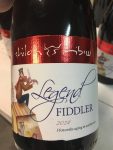 Legend, the wine is a blend of Petite Sirah (39%), Petite Verdot (32%) and Shiraz (29%) which spent 16 months in 25% new French and American oak. With a rich and ripe nose of black plums, cassis, crushed black forest berries, spicy oak, baker’s chocolate and cigar box, the wine’s rich and expressive nose is an accurate precursor to the fleshy and rich full bodied palate that follows. While slightly sweeter than I would like, the wine will be loved by most and is a deliciously rich wine on a well balanced background of rustic tannins and good acidity that will continue to improve in the bottle over the next few years. 14.6% AbV. Drink 2018-2021 (this note refers to the non-mevushal version but the US will only receive the mevushal version).
Legend, the wine is a blend of Petite Sirah (39%), Petite Verdot (32%) and Shiraz (29%) which spent 16 months in 25% new French and American oak. With a rich and ripe nose of black plums, cassis, crushed black forest berries, spicy oak, baker’s chocolate and cigar box, the wine’s rich and expressive nose is an accurate precursor to the fleshy and rich full bodied palate that follows. While slightly sweeter than I would like, the wine will be loved by most and is a deliciously rich wine on a well balanced background of rustic tannins and good acidity that will continue to improve in the bottle over the next few years. 14.6% AbV. Drink 2018-2021 (this note refers to the non-mevushal version but the US will only receive the mevushal version).
Shiloh, Legend, Choni, 2014: Rebranded from the previous and  popular Legend II, the wine’s title pays homage to the Talmudic sage Choni HaMa’agel who is best known for his successful stand-off with G-d that yielded desperately needed rain as a respite for the drought-induced parched earth but has a rich history beyond that story as well. A blend of Cabernet Sauvignon (65%), Malbec (18%) and Cabernet Franc (17%), the wine spent 16-18 months aging in 40% new French oak barrels and clocks in at 15.5% AbV. With a rich and vibrant nose of primarily dark fruit tinged with bright tart red notes and a hint of blueberries, the wine has a medium bodied palate with nicely integrating tannins and plenty more fruit that is well balanced with slightly toasted oak, warm spices and dark chocolate along with a tinge of roasted Mediterranean herbs, the wine is lovely with a graceful elegance to it and will go well with many dishes while also being highly enjoyable on its own. Drink now through 2022 [mevushal].
popular Legend II, the wine’s title pays homage to the Talmudic sage Choni HaMa’agel who is best known for his successful stand-off with G-d that yielded desperately needed rain as a respite for the drought-induced parched earth but has a rich history beyond that story as well. A blend of Cabernet Sauvignon (65%), Malbec (18%) and Cabernet Franc (17%), the wine spent 16-18 months aging in 40% new French oak barrels and clocks in at 15.5% AbV. With a rich and vibrant nose of primarily dark fruit tinged with bright tart red notes and a hint of blueberries, the wine has a medium bodied palate with nicely integrating tannins and plenty more fruit that is well balanced with slightly toasted oak, warm spices and dark chocolate along with a tinge of roasted Mediterranean herbs, the wine is lovely with a graceful elegance to it and will go well with many dishes while also being highly enjoyable on its own. Drink now through 2022 [mevushal].
“Secret”
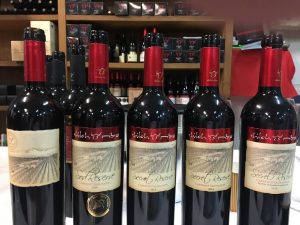 Our tasting included a mini vertical for each of the three varietal wines in the secret (“Sod”) series which typically spend 18 months in French oak – Shiraz (2008. 2009 and 2010), Cabernet Sauvignon (2006, 2008, 2013, 2014 and 2015) and Merlot (2009 and 2014). While I find that Shiloh’s best grape is Merlot, the varietal Cabernet Sauvignon is the star of this series as Amichai utilizes the best barrels of Merlot for the winery’s flagship Mosaic.
Our tasting included a mini vertical for each of the three varietal wines in the secret (“Sod”) series which typically spend 18 months in French oak – Shiraz (2008. 2009 and 2010), Cabernet Sauvignon (2006, 2008, 2013, 2014 and 2015) and Merlot (2009 and 2014). While I find that Shiloh’s best grape is Merlot, the varietal Cabernet Sauvignon is the star of this series as Amichai utilizes the best barrels of Merlot for the winery’s flagship Mosaic.
Shiloh, Secret, Cabernet Sauvignon, 2006: One of Amichai’s  inaugural wines that benefited from his multiple experiments with various barrels, as only his favorites made it into this varietal wine. Still showing the great structure and balanced acidity from its youth, the wine provides plenty of tertiary notes including well-worn saddle leather, earthy minerals and anise while the spicy oak has taken on a more dominant role. Sliding past peak, the wine needs a little bit of air to “put its face on” but is still enjoyable at “only” 13.9% AbV with sweet red fruit and plenty of Shiloh’s characteristic good acidity keeping things real along with the 16 months the wine spent aging in French oak, at least for a little while longer. Drink now.
inaugural wines that benefited from his multiple experiments with various barrels, as only his favorites made it into this varietal wine. Still showing the great structure and balanced acidity from its youth, the wine provides plenty of tertiary notes including well-worn saddle leather, earthy minerals and anise while the spicy oak has taken on a more dominant role. Sliding past peak, the wine needs a little bit of air to “put its face on” but is still enjoyable at “only” 13.9% AbV with sweet red fruit and plenty of Shiloh’s characteristic good acidity keeping things real along with the 16 months the wine spent aging in French oak, at least for a little while longer. Drink now.
Shiloh, Secret, Cabernet Sauvignon, 2013: The first vintage after the 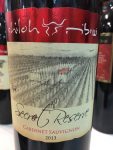 shift to higher quality vineyards and oak barrels and reflecting the qualitative upgrade, this is a very nice wine. With plenty of ripe and extracted rich black and red fruit including blackberries, plums, cherries, cassis and a hint of red plums, the wine is dominated by powerful but controlled tannins and spicy oak that need time to settle down. Give the wine an hour or so of air in order to reap the benefits of the rich fruit, cigar box, a pleasing whiff of smoke and a herbal overlay with nuances of minty chocolate; and enjoy this powerful and well made blockbuster of a wine that clocks in at 15.1% AbV and lingers long. A little on the sweet side for my personal tastes, the wine will be well-received by Shiloh’s many adoring fans and justifiably so. Drink now (with an hour of decanting) through 2022, maybe longer [non-mevushal but there is also a mevushal version].
shift to higher quality vineyards and oak barrels and reflecting the qualitative upgrade, this is a very nice wine. With plenty of ripe and extracted rich black and red fruit including blackberries, plums, cherries, cassis and a hint of red plums, the wine is dominated by powerful but controlled tannins and spicy oak that need time to settle down. Give the wine an hour or so of air in order to reap the benefits of the rich fruit, cigar box, a pleasing whiff of smoke and a herbal overlay with nuances of minty chocolate; and enjoy this powerful and well made blockbuster of a wine that clocks in at 15.1% AbV and lingers long. A little on the sweet side for my personal tastes, the wine will be well-received by Shiloh’s many adoring fans and justifiably so. Drink now (with an hour of decanting) through 2022, maybe longer [non-mevushal but there is also a mevushal version].
Shiloh, Secret, Cabernet Sauvignon, 2014: Similar to the 2014 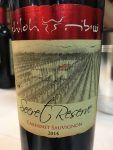 version but having spent only 18 months in French oak, the wine shows sweeter fruit than the 2013 vintage but showcases even better structure and a more harmonious blending of the wine’s various components. Loaded with a rich and expressive nose of ripe blackberries, dark cherries, black currants along with plenty of rich dark chocolate, mocha and warm roasted herbs enhanced by Oriental spices, the wine slowly reveals layer after layer of complexity if you can give it the time it needs (and enjoy the sweet fruit). More approachable now than the 2013 and better made, it will continue to improve in the bottle over the next few years but will likely evolve a little less than its younger sibling. 15.3% AbV. Drink now through 2022 [mevushal but also produced in a non-mevushal version].
version but having spent only 18 months in French oak, the wine shows sweeter fruit than the 2013 vintage but showcases even better structure and a more harmonious blending of the wine’s various components. Loaded with a rich and expressive nose of ripe blackberries, dark cherries, black currants along with plenty of rich dark chocolate, mocha and warm roasted herbs enhanced by Oriental spices, the wine slowly reveals layer after layer of complexity if you can give it the time it needs (and enjoy the sweet fruit). More approachable now than the 2013 and better made, it will continue to improve in the bottle over the next few years but will likely evolve a little less than its younger sibling. 15.3% AbV. Drink now through 2022 [mevushal but also produced in a non-mevushal version].
Shiloh, Secret, Cabernet Sauvignon, 2015 [Advance Tasting]: As 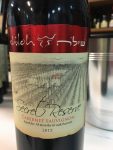 Royal Wines (Shiloh’s US importer) doesn’t import Shmitah year wines; this vintage was made solely for the domestic market and is only available as a non-mevushal wine. Continuing the upward qualitative trajectory, the wine is well made with good balance and structure and should age nicely with continued improvement in the bottle. Blackberries, black cherries, ripe plums and chocolate dominate the nose along with nice notes of toasty oak, sage, eucalyptus and fresh pulled espresso, much of which continues onto the full bodied luxurious palate which is currently dominated by powerfully robust tannins that need time to settle down. Give the wine a chance and you will be rewarded with layers of rich but controlled mostly black fruit with a lovely herbacousness, dark chocolate, slightly smoky oak and cedar wood providing lovely complexity and a pleasing deliciousness that makes this wine a worthy acquisition. 14.7% AbV. At this point, the wine needs at least 2 hours of decanting and I’d hold off drinking for another 12 months at least before drinking from 2019 through 2024 [Shmitah / Only in Israel].
Royal Wines (Shiloh’s US importer) doesn’t import Shmitah year wines; this vintage was made solely for the domestic market and is only available as a non-mevushal wine. Continuing the upward qualitative trajectory, the wine is well made with good balance and structure and should age nicely with continued improvement in the bottle. Blackberries, black cherries, ripe plums and chocolate dominate the nose along with nice notes of toasty oak, sage, eucalyptus and fresh pulled espresso, much of which continues onto the full bodied luxurious palate which is currently dominated by powerfully robust tannins that need time to settle down. Give the wine a chance and you will be rewarded with layers of rich but controlled mostly black fruit with a lovely herbacousness, dark chocolate, slightly smoky oak and cedar wood providing lovely complexity and a pleasing deliciousness that makes this wine a worthy acquisition. 14.7% AbV. At this point, the wine needs at least 2 hours of decanting and I’d hold off drinking for another 12 months at least before drinking from 2019 through 2024 [Shmitah / Only in Israel].
Shiloh, Secret, Merlot, 2009: Easily Shiloh’s most dominant 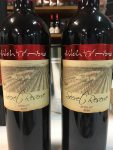 varietal and the least oftenly made (and never in mevushal form), approximately 60% of the grapes are sourced from the winery’s Shomron vineyards with the rest coming from the Dalton area. As with the other Secret wines, it spent between 18-20 months in mostly new French oak before being bottled. While showing good capacity for oak, the spicy oak was a little too dominant for my personal tastes, even 8 years past harvest. However the wine is still incredibly closed and tight with good structure that bodes well for the coming years and 2 hours of air softened the oak dominance somewhat (which allowed the lovely fruit and earthy minerals to shine through along with the characteristic herbal overlay that defines many of Shiloh’s wines). 14.5% AbV. Potentially a powerhouse of a wine that has plenty to offer, I’d hold out opening any remaining bottles for another 6-12 months before giving the wine another try – chances are you’ll be pleasantly surprised and if so, the wine should cellar comfortably through 2020.
varietal and the least oftenly made (and never in mevushal form), approximately 60% of the grapes are sourced from the winery’s Shomron vineyards with the rest coming from the Dalton area. As with the other Secret wines, it spent between 18-20 months in mostly new French oak before being bottled. While showing good capacity for oak, the spicy oak was a little too dominant for my personal tastes, even 8 years past harvest. However the wine is still incredibly closed and tight with good structure that bodes well for the coming years and 2 hours of air softened the oak dominance somewhat (which allowed the lovely fruit and earthy minerals to shine through along with the characteristic herbal overlay that defines many of Shiloh’s wines). 14.5% AbV. Potentially a powerhouse of a wine that has plenty to offer, I’d hold out opening any remaining bottles for another 6-12 months before giving the wine another try – chances are you’ll be pleasantly surprised and if so, the wine should cellar comfortably through 2020.
Shiloh, Secret, Merlot, 2014: 2014 was certainly a good year for the winery and this wine is simply another example of the winery’s meticulous winemaking. With powerful and slowly integrating tannins providing great backbone and well balanced with great acidity and voluptuous but controlled rich dark fruit enhanced by tart red raspberry and sweet, chocolate-covered cherries, this full-bodied wine isn’t yet ready for prime time but is well-worth stocking up and cellaring as it promises to evolve into something special. 15.5% AbV. Drink 2019 through 2024, maybe longer.
Single Vineyard / Hero’s Edition
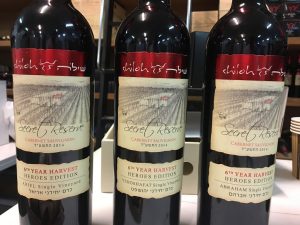 As noted above, this special series pays homage to the hero Jewish farmer’s who keep Shmitah in the face of potential economic adversity while trusting G-d to keep his promise and provide extra bounty during the pre-Shmitah vintage (in this case, the 2014 vintage). Only available in the US and directly from the winery, the wine is sold as a set of three single vineyard Cabernet Sauvignon wines, each labeled with the vineyard’s owner in tribute to their religious heroism (and marked as a “unique” vineyard in Hebrew instead of “single”).
As noted above, this special series pays homage to the hero Jewish farmer’s who keep Shmitah in the face of potential economic adversity while trusting G-d to keep his promise and provide extra bounty during the pre-Shmitah vintage (in this case, the 2014 vintage). Only available in the US and directly from the winery, the wine is sold as a set of three single vineyard Cabernet Sauvignon wines, each labeled with the vineyard’s owner in tribute to their religious heroism (and marked as a “unique” vineyard in Hebrew instead of “single”).
Shiloh, Secret, 6th Year Harvest Hero’s Edition, Cabernet Sauvignon, Ariel, 2014: Sourced from a vineyard located in Yitzhar, the wine spent just over 20 months aging in 500 liter new oak barrels. With a subdued nose of mostly black fruit tinged with blue, the wine’s full bodied palate is very tight and closed but with great structure and balance that promises some serious aging ability. With sweet ripe fruit and chocolate dominating the palate alongside toasted oak and a herbaceous overlay, the wine needs 12-18 months before being ready for primetime (if opened now, I’d give the wine between two and three hours in the decanter). 15.1% AbV. Drink 2019 through 2024.
Shiloh, Secret, 6th Year Harvest Hero’s Edition, Cabernet Sauvignon, Yehoshafat, 2014: ever more closed than the Ariel version, the wine took hours before it would even crack a smile and allow a glimpse and he ripe black fruit hiding behind the searing tannin which is back up nicely by great acidity. Sourced from a vineyard located in Chavat Ma’ayan, the wine spent 20 months aging in 90% new oak barrels before release. Plenty of spices and herbal notes provide complexity and ripe plum, black current, tart raspberries, dried cranberries and rich dark chocolate all coming together nicely in a totally delicious way. The best of the series and maybe my favorite wine from Shiloh to date. 15.4% AbV. Drink 2019 through 2025, maybe longer.
Shiloh, Secret, 6th Year Harvest Hero’s Edition, Cabernet Sauvignon, Avraham, 2014: Sourced from a vineyard located in Itamar, the wine spent 22 months aging in 75% new oak barrels. 14.9% AbV. The most approachable of the three wines, potentially resulting from the smallest percentage of new oak, the wine was enjoyable after 30 minutes in the glass while continuing to evolve over three hours while showcasing rich chocolate laden fruit with earthy minerals and roasted herbs providing nuanced complexity along with slightly toasted oak and floral notes. Great balance and representative of Amichai’s ever-increasing winemaking skills and meticulous attention to detail. Drink now through 2023.
“Mosaic”
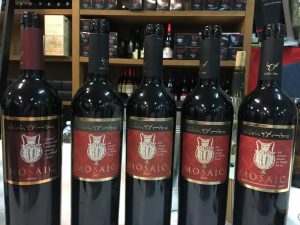 Amichai ages each component separately for 11 months before building the final blend which spends another seven months in oak getting acquainted. Historically the winery held on to the wine for an additional 1-2 years of bottle aging but increased market demand in recent years has required earlier release (and thus less bottle aging at the winery). Placing the region’s acclaimed front and center, the winery’s flagship blend has been showing marked improvement in recent years. In addition to the wines listed below, we also tasted the 2007 (which is in Drink Now mode), the 2013 and the 2015 Shmitah version (an advance tasting which will only be available in Israel). While the inaugural 2006 vintage wasn’t part of our tasting, recent tastings indicate the wine is showing very nicely, with one or two years of solid drinking ahead of it, so drink now.
Amichai ages each component separately for 11 months before building the final blend which spends another seven months in oak getting acquainted. Historically the winery held on to the wine for an additional 1-2 years of bottle aging but increased market demand in recent years has required earlier release (and thus less bottle aging at the winery). Placing the region’s acclaimed front and center, the winery’s flagship blend has been showing marked improvement in recent years. In addition to the wines listed below, we also tasted the 2007 (which is in Drink Now mode), the 2013 and the 2015 Shmitah version (an advance tasting which will only be available in Israel). While the inaugural 2006 vintage wasn’t part of our tasting, recent tastings indicate the wine is showing very nicely, with one or two years of solid drinking ahead of it, so drink now.
Shiloh, Mosaic, 2011: A blend of Merlot (45%), cabernet Franc 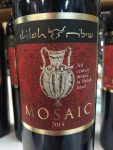 (21%), Petit Verdot (20%) and Cabernet Sauvignon (14%) that spent a collective 20 months in French oak, the wine is rich and powerful with an understated elegance that bodes well for its future. A lovely wine with great structure and terrific balance, the nose is very tight and requires hours of air (or vigorous swirling) before one can enjoy the black fruit, tart cherries, ripe plums, currants, and other ripe sweet fruit that are controlled and provide a pleasing contra to the toasty oak, minerals and roasted herbs that are enhanced by brown sweet spices and just-cracked black pepper. Powerful, elegant and delicious but not as complex as one would have expected. 14.7% AbV. Drink now through 2020 [mevushal but also produced in a non-mevushal version].
(21%), Petit Verdot (20%) and Cabernet Sauvignon (14%) that spent a collective 20 months in French oak, the wine is rich and powerful with an understated elegance that bodes well for its future. A lovely wine with great structure and terrific balance, the nose is very tight and requires hours of air (or vigorous swirling) before one can enjoy the black fruit, tart cherries, ripe plums, currants, and other ripe sweet fruit that are controlled and provide a pleasing contra to the toasty oak, minerals and roasted herbs that are enhanced by brown sweet spices and just-cracked black pepper. Powerful, elegant and delicious but not as complex as one would have expected. 14.7% AbV. Drink now through 2020 [mevushal but also produced in a non-mevushal version].
Shiloh, Mosaic, 2014: Dense, extracted and full bodied, the wine is  loaded with black fruit, blueberries, rich chocolate, forest floor, underbrush, sage, freshly rolled cigars, cedar wood and, while lacking complexity was the best Mosaic (other than the original 2006). Rich and voluptuously ripe fruit that presented on the sweet side but will be loved by Shiloh’s many fans, the wine was well made, with robust tannins holding down the fort and plenty of acidity keeping things real. Drink now through 2022 [mevushal; also made non-mevushal]
loaded with black fruit, blueberries, rich chocolate, forest floor, underbrush, sage, freshly rolled cigars, cedar wood and, while lacking complexity was the best Mosaic (other than the original 2006). Rich and voluptuously ripe fruit that presented on the sweet side but will be loved by Shiloh’s many fans, the wine was well made, with robust tannins holding down the fort and plenty of acidity keeping things real. Drink now through 2022 [mevushal; also made non-mevushal]
Shiloh, Mosaic, Exclusive Edition, 2013: A blend of Cabernet 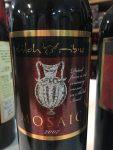 Sauvignon (73%), Syrah (21%) and Cabernet Franc (6%) which spent 20 months aging in 60% new French oak barrels, the wine was initially intended as a one-off production intended to take advantage of some extra special barrels Amichai felt were exceptionally extraordinary and deserving of a separate stage from which to shine. Given the commercial success of the inaugural limited edition of 3,800 bottles and the subsequent exceptional 2014 vintage year, the winery can be forgiven for producing it again for 2014, but we shall see if it remains a very special wine that justifies the almost double retail price or becomes a regular staple of Shiloh’s expanding portfolio. Rich, deep and brooding with nicely integrating and caressing tannin that still needs time and great acidity providing a core around which the ripe sweet black fruit, blueberry, cassis, minerals and toasty oak come together in harmonious balance with rosemary, eucalyptus and sage providing some pleasing bitterness along with prunes, dried fruit, warm spices, fresh-cracked black pepper and rich dark chocolate with some lavender and floral nuances and a long lingering and caressing finish packed with more warm spices and star anise. 14.3% AbV. Drink now through 2022.
Sauvignon (73%), Syrah (21%) and Cabernet Franc (6%) which spent 20 months aging in 60% new French oak barrels, the wine was initially intended as a one-off production intended to take advantage of some extra special barrels Amichai felt were exceptionally extraordinary and deserving of a separate stage from which to shine. Given the commercial success of the inaugural limited edition of 3,800 bottles and the subsequent exceptional 2014 vintage year, the winery can be forgiven for producing it again for 2014, but we shall see if it remains a very special wine that justifies the almost double retail price or becomes a regular staple of Shiloh’s expanding portfolio. Rich, deep and brooding with nicely integrating and caressing tannin that still needs time and great acidity providing a core around which the ripe sweet black fruit, blueberry, cassis, minerals and toasty oak come together in harmonious balance with rosemary, eucalyptus and sage providing some pleasing bitterness along with prunes, dried fruit, warm spices, fresh-cracked black pepper and rich dark chocolate with some lavender and floral nuances and a long lingering and caressing finish packed with more warm spices and star anise. 14.3% AbV. Drink now through 2022.